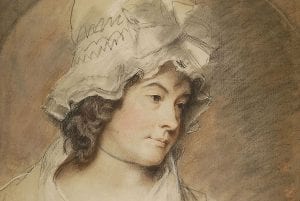Charlotte Turner Smith (1749-1806), a major British, Romantic-era author, began her publishing career with her popular and influential Elegiac Sonnets, published in ten ever-expanding editions between 1784 and 1800. These innovative poems initiated the Romantic sonnet revival, a major experimental verse movement to which Samuel Taylor Coleridge, John Keats, Mary Robinson, Percy Bysshe Shelley, and William Wordsworth all contributed. Fellow poet John Thewall ranked Smith’s sonnets as highly as Shakespeare’s plays and Milton’s epics. In 1793, Smith published The Emigrants, a long blank verse poem that depicts refugees fleeing France following the French Revolution and the Reign of Terror.
Smith published ten novels that shaped trends in gothic, sentimental, historical, comedic, and protest fiction. Having begun to write fiction after the American Revolution ended and continuing through the French Revolution and the War with France, Smith commented on her historical moment through her characters and international settings in novels such as Desmond (1792) and The Old Manor House (1793). In addition, Smith, like her contemporaries Mary Wollstonecraft and Mary Hays, depicted in her novels the material circumstances of women’s oppression in England in novels including Emmeline (1788) and The Young Philosopher (1798). Sir Walter Scott identified Smith as one of the finest novelists of the eighteenth century, and Jane Austen looked to her as a model. Based on the education of her own children at home, Smith also composed six delightful children’s books that teach science, poetics, English history, ethics, social observation, and art. She also wrote a play.
Smith ended her writing career as she began it–with poetry. As she was dying from uterine cancer at age 57, she wrote her final poem, Beachy Head, published posthumously. This thematically capacious poem offers an extended exploration of the natural and political history of the iconic landform Beachy Head on the southeast coast of England, as well as a meditation on happiness and purpose in life.
For more information about Smith’s fascinating biography, see The Charlotte Smith Story Map.
